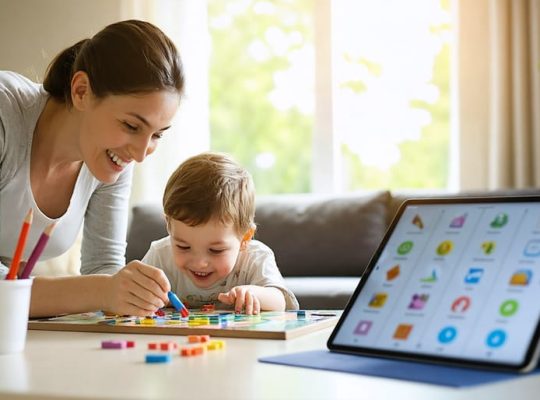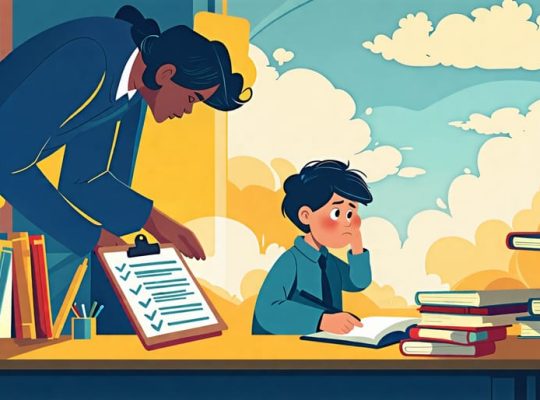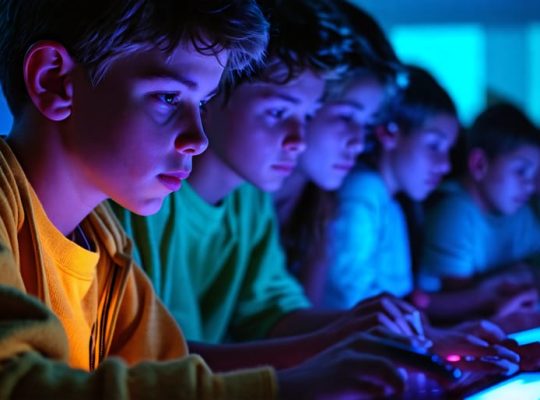As parents, we all want to protect our children while embracing technology’s potential benefits. Virtual reality stands at this delicate intersection, promising immersive educational experiences while raising valid concerns about its impact on developing minds. Recent studies from Stanford’s Virtual Human Interaction Lab reveal both promising advantages and potential risks of VR technology, making it crucial for families to understand its true effects.
Like many digital innovations before it, virtual reality isn’t inherently good or bad – it’s how we use it that matters. While researchers have found that controlled VR exposure can enhance learning, spatial awareness, and creativity in children, they’ve also identified risks including eye strain, motion sickness, and potential psychological effects from excessive immersion.
What makes VR unique is its unprecedented level of engagement with our sensory systems. Unlike traditional screens, VR creates a complete alternate reality that can influence brain development, social interactions, and physical well-being in ways we’re still working to understand. As more families bring VR headsets into their homes, parents need practical, evidence-based guidance to make informed decisions about their children’s virtual reality use.
Understanding Virtual Reality and Child Development
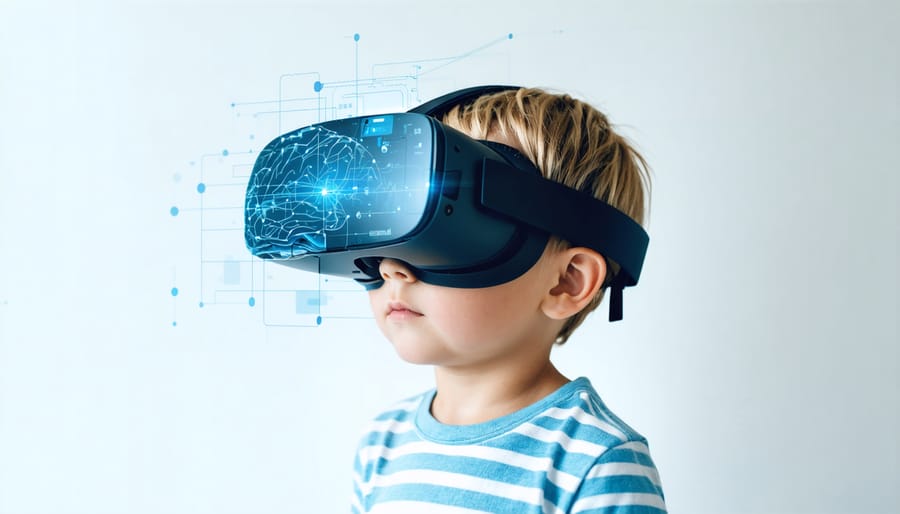
How Children Process Virtual Experiences
Children process virtual experiences quite differently from adults, largely due to their still-developing brains and limited ability to distinguish between virtual and real experiences. Dr. Sarah Chen, a pediatric neurologist, explains that children under 12 are particularly susceptible to believing their virtual experiences are real, even after removing the headset.
Unlike adults, who can easily compartmentalize virtual experiences, children’s brains may continue processing VR interactions as genuine memories. This can be both fascinating and concerning – while it enhances their learning potential in educational VR applications, it also means frightening or intense virtual experiences might have a stronger emotional impact.
Research shows that children’s spatial awareness and depth perception are still developing, making them more vulnerable to motion sickness and disorientation in VR environments. Additionally, their enhanced neuroplasticity means virtual experiences may have a more lasting impact on their neural pathways compared to adults.
This unique processing doesn’t necessarily mean VR is harmful, but it does highlight the importance of age-appropriate content and supervised usage. As one parent shared, “We noticed our 8-year-old was much more emotionally invested in her virtual zoo visits than we expected, treating the digital animals as if they were real friends.”
Age-Appropriate VR Usage
Most VR headset manufacturers recommend their devices for children aged 13 and above, though some set the minimum age at 7 or 8 for specific educational content. As a parent and former pediatric occupational therapist shares, “I limit my 10-year-old’s VR sessions to 20 minutes, with regular breaks for movement and eye rest.”
For teens 13-17, experts suggest limiting VR sessions to 30-45 minutes, followed by at least a 15-minute break. Adults can typically handle longer sessions but should still take regular breaks every hour. Dr. Sarah Chen, a pediatric ophthalmologist, emphasizes that “the developing visual system in children needs regular breaks from close-focus activities, including VR.”
Consider implementing these age-appropriate guidelines:
– Ages 7-12: Maximum 20 minutes per session, with adult supervision
– Ages 13-17: Up to 45 minutes per session, with hourly breaks
– Adults: 60-minute sessions maximum, with 15-minute breaks
Remember to monitor your child for signs of discomfort, such as eye strain or dizziness, and adjust usage accordingly. Creating a balanced schedule that includes physical activity and real-world social interaction helps ensure healthy VR integration into daily life.
Potential Benefits of VR for Children’s Mental Health
Therapeutic Applications
While concerns about virtual reality’s potential negative effects are valid, it’s important to recognize its remarkable therapeutic applications. Medical professionals and therapists increasingly use VR as a powerful tool for treating anxiety in children and adults alike, offering a safe environment to face fears and develop coping strategies.
Sarah Thompson, a child psychologist, shares how VR helped one of her young patients overcome a severe fear of heights: “Through gradual exposure in a controlled virtual environment, Tommy went from being terrified of climbing stairs to confidently riding elevators within just eight sessions.”
VR therapy has shown promising results in treating various conditions:
– Phobias and specific fears
– Post-traumatic stress disorder (PTSD)
– Social anxiety
– Pain management during medical procedures
– Physical rehabilitation
What makes VR therapy particularly effective is its ability to create realistic scenarios while maintaining complete control over the experience. Children can practice social skills, face challenging situations, or work through trauma at their own pace, all under professional guidance. The immersive nature of VR helps build confidence and develop practical coping mechanisms that transfer to real-world situations.
Dr. James Martinez, a pediatric mental health specialist, emphasizes: “When used therapeutically, VR becomes a powerful ally in mental health treatment, especially for young patients who might find traditional therapy challenging or intimidating.”
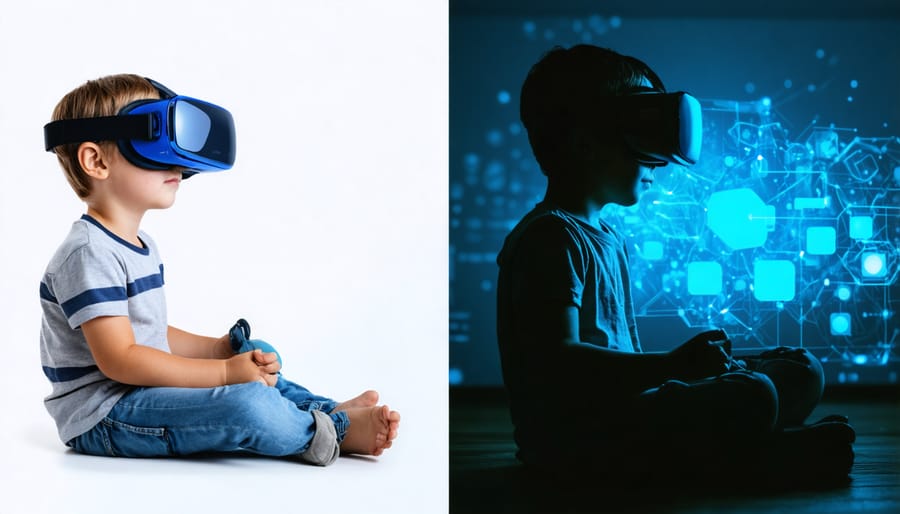
Educational and Social Development
Virtual reality offers significant educational advantages when used thoughtfully and in moderation. Students can explore historical sites, conduct virtual science experiments, and experience complex concepts in immersive 3D environments. For example, a middle school student studying ancient Rome can virtually walk through the Colosseum, gaining a deeper understanding than traditional textbook learning alone could provide.
Research has shown that the therapeutic benefits of digital experiences extend to social skill development, particularly for children who struggle with traditional social interactions. VR platforms can provide safe spaces for practicing social scenarios, building confidence, and developing communication skills under guidance.
Educational VR applications have shown promising results in special education, helping children with autism spectrum disorders learn social cues and emotional recognition through controlled, repeatable scenarios. Many educators report increased student engagement and better retention of information when incorporating VR elements into their lessons.
However, it’s essential to balance virtual experiences with real-world interactions. VR should complement, not replace, traditional learning and social development. Parents and educators should establish clear guidelines for VR use, ensuring children maintain healthy relationships and engage in diverse learning experiences both inside and outside virtual environments.
Mental Health Risks and Concerns
Anxiety and Stress
Virtual reality experiences can sometimes trigger anxiety and stress in users, particularly in children who may be more sensitive to immersive environments. As parents increasingly report digital anxiety concerns, it’s important to understand how VR might affect your child’s emotional well-being.
Common stress triggers in VR include intense gaming scenarios, fear of heights in virtual environments, and the sensation of being overwhelmed by the immersive experience. Some children report feeling anxious when the virtual world doesn’t align with their physical movements, leading to temporary disorientation.
Dr. Sarah Chen, a child psychologist, shares: “While most children adapt well to VR, some may experience increased anxiety, especially if they’re prone to stress in new situations. Parents should monitor their child’s comfort level and take regular breaks.”
To minimize anxiety, encourage short VR sessions, choose age-appropriate content, and maintain open communication about your child’s experiences. If your child shows signs of distress, such as excessive worry or reluctance to use VR, consider limiting exposure or consulting a healthcare professional.
Social Isolation
While virtual reality can offer incredible social experiences, excessive VR use may lead to real-world social isolation, particularly in children and teenagers. Dr. Sarah Martinez, a child psychologist, notes that when young people spend too much time in virtual environments, they might miss out on developing crucial face-to-face social skills.
“I’ve worked with families where children prefer their VR social interactions over real ones,” shares Dr. Martinez. “While these virtual connections can be meaningful, they shouldn’t completely replace traditional social development opportunities.”
Parents often report that their children become increasingly withdrawn from family activities and real-world friendships as their VR usage increases. This isolation can impact emotional development, empathy-building, and the ability to read non-verbal cues – skills that are best learned through in-person interactions.
However, moderation is key. VR can actually enhance social connections when used appropriately, especially for children who struggle with traditional social settings. The goal is to find a healthy balance between virtual and real-world social interactions.
Consider setting regular “tech-free” family times and encouraging participation in physical social activities alongside VR use. This approach helps ensure children maintain strong real-world connections while enjoying the benefits of virtual social experiences.
Reality Disconnection
One of the most common concerns parents share is their children’s ability to distinguish between virtual and real experiences. Dr. Sarah Chen, a child psychologist specializing in digital media effects, explains that young minds are still developing their sense of reality, making them more susceptible to confusion between virtual and physical worlds.
When children spend significant time in immersive VR environments, they might temporarily experience what experts call “reality disconnection” – a state where the brain needs time to readjust to the physical world. Think of it as similar to the sensation of stepping onto solid ground after being on a boat.
To help children maintain a healthy connection with reality, experts recommend setting clear boundaries between VR play and real-world activities. “It’s essential to create transition periods,” suggests Dr. Chen. “Have your child take regular breaks and engage in physical activities or face-to-face interactions after VR sessions.”
Parents can also help by discussing VR experiences with their children, emphasizing the differences between virtual and real environments. Simple conversations like “That was a fun game, but now we’re back in our real world” can help reinforce this distinction and keep children grounded in reality.
Creating Healthy VR Boundaries
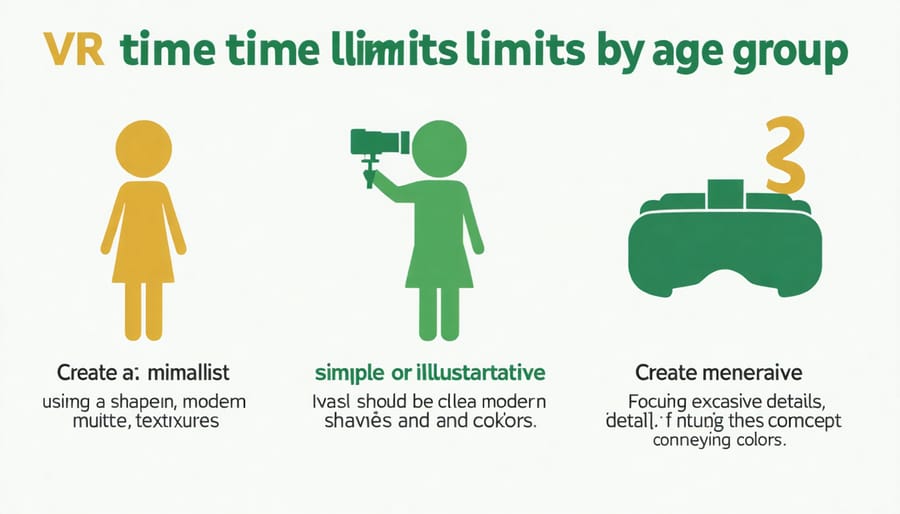
Setting Time Limits
Just like traditional screen time limits, setting boundaries for VR usage is essential for your child’s wellbeing. Most experts recommend limiting VR sessions to 20-30 minutes at a time for children, with regular breaks in between. For teens and adults, sessions can extend to 45-60 minutes, but should still include 10-15 minute breaks every hour.
Dr. Sarah Chen, a pediatric ophthalmologist, shares: “I advise my patients’ families to follow the 20-20-20 rule: after 20 minutes of VR use, take a 20-second break and look at something 20 feet away to reduce eye strain.”
Consider creating a VR schedule that works for your family. For example:
– Limit weekday sessions to 30 minutes
– Allow slightly longer sessions on weekends (45-60 minutes)
– Ensure at least 2 hours between VR sessions
– Avoid VR use before bedtime, as it can interfere with sleep
Watch for signs that your child needs a break, such as:
– Complaints of dizziness or headaches
– Eye rubbing or squinting
– Loss of balance
– Decreased awareness of surroundings
Remember, these guidelines are flexible and should be adjusted based on your child’s age, sensitivity, and individual needs. Some children might need shorter sessions, while others may handle longer ones comfortably.
Monitoring Content and Behavior
As parents and caregivers, it’s essential to stay involved in your child’s VR experiences. Start by reviewing content ratings and descriptions before allowing access to VR apps or games. Many VR platforms offer parental controls and age-appropriate content filters – make sure to set these up before first use.
Watch for warning signs that might indicate unhealthy VR habits. These can include irritability when asked to stop using VR, complaints about headaches or eye strain, or avoiding real-world social interactions in favor of virtual ones. If you notice these signs, it’s time to reassess and adjust usage patterns.
Create a “VR agreement” with your child that outlines clear boundaries around content and behavior. This might include rules about which games are acceptable, time limits, and appropriate online interactions with other users. Consider making VR use a shared activity – join your child occasionally to better understand their virtual experiences and maintain open communication.
Regular check-ins are crucial. Ask about their favorite VR activities, any concerns they have, and how they’re feeling physically and emotionally after sessions. Pay special attention to content that might be too intense or inappropriate for their age group, such as violent games or realistic simulations that could cause anxiety.
Remember, moderation is key. By staying engaged and setting healthy boundaries, you can help ensure VR remains a positive part of your child’s digital experience.
Virtual reality, like many technological innovations, isn’t inherently good or bad – it’s all about how we use it. Throughout this article, we’ve explored both the exciting potential and legitimate concerns surrounding VR use, particularly for young people. The research shows that when used responsibly and in moderation, VR can be a valuable tool for learning, social connection, and entertainment.
For parents wondering about letting their children use VR, remember that balance is key. Setting reasonable time limits, ensuring age-appropriate content, and maintaining open communication about VR experiences can help create a healthy relationship with this technology. Many families find success with simple guidelines like taking regular breaks, using VR in well-lit rooms, and making it part of a varied mix of activities rather than the primary source of entertainment.
The potential physical effects, such as eye strain or motion sickness, are typically temporary and can be minimized with proper use. As for psychological impacts, current evidence suggests that VR itself doesn’t pose unique risks when used appropriately. In fact, many children benefit from the interactive learning experiences and creative opportunities VR provides.
Moving forward, stay informed about VR developments and trust your parental instincts. With thoughtful boundaries and supervision, VR can be a safe, enriching part of your child’s digital world. Remember, you’re not alone in navigating these decisions – many parents and experts are working together to understand and optimize VR use for the next generation.


